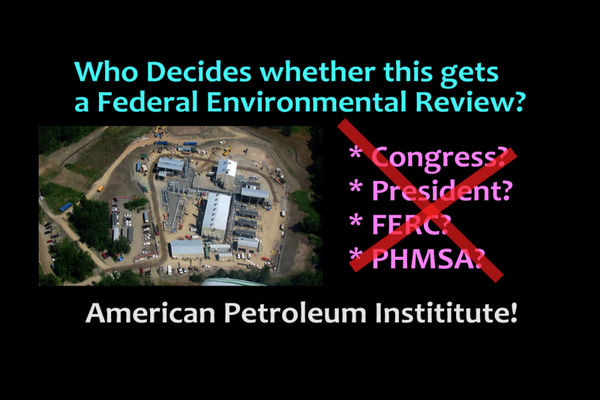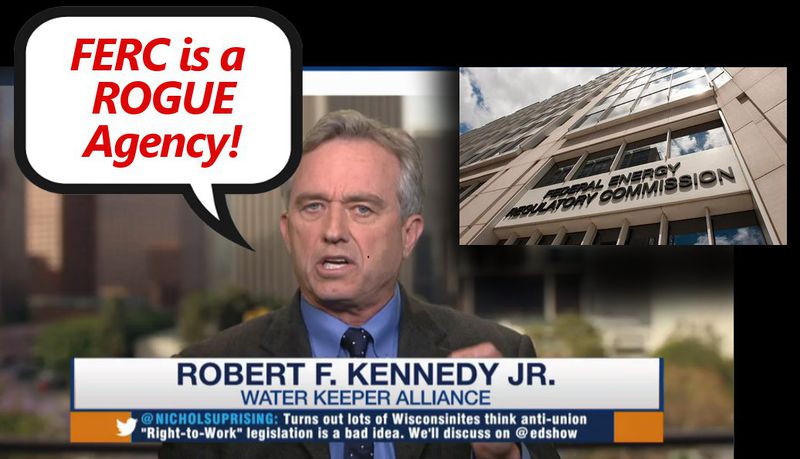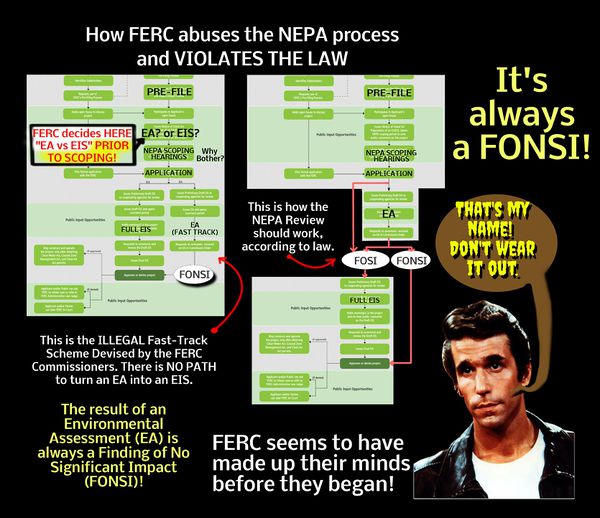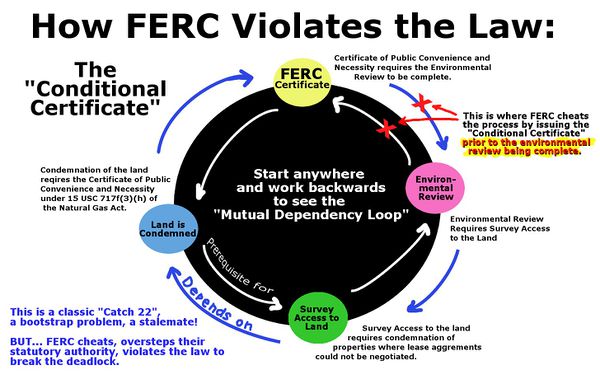FERC Violations of Law
The Federal Energy Regulatory Commission (FERC) is chartered under the Natural Gas Act, and the National Environmental Policy Act (NEPA) to perform various duties, including [1]:
- Approves the siting and abandonment of interstate natural gas pipelines and storage facilities;
- Ensures the safe operation and reliability of proposed and operating LNG terminals;
- Enforces FERC regulatory requirements through imposition of civil penalties and other means;
- Oversees environmental matters related to natural gas and hydroelectricity projects and other matters
- Rate regulation:
- Regulates the transmission and sale of natural gas for resale in interstate commerce;
- Regulates the transportation of oil by pipeline in interstate commerce;
This page is focused on the laws governing the siting (and often related abandonment) of new natural gas facilities (pipelines, compressors, underground storage, LNG storage, LNG exports), and the required environmental review. This is how most members of the public interact with FERC.
The final result of the FERC application process is the issuance (usually) or not, of a Certificate of Public Convenience and Necessity. This Certificate can functionally be thought of as a permit.
FERC routinely abuses and violates the law regarding siting new facilities. FERC also violates their own rules, which carry the force of law, and orders of the Federal Courts. Many people have called FERC a "rogue agency"[2]
This page will document the various ways FERC routinely violates these laws.
This page presently details the various laws and regulations which govern how FERC does its application review. It would help me (and others) tremendously if you can send me specific examples of how FERC has violated these various laws.
This page is a stub, and under development. If you have content to add, or want to become an editor, please email the FERC section curator: William Huston WilliamAHuston@gmail.com
Contents
- 1 Federal Laws
- 1.1 National Environmental Policy Act
- 1.2 Natural Gas Act
- 1.3 Coastal Zone Management Act 1972
- 1.4 Clean Water Act
- 1.5 Clean Air Act
- 1.6 Endangered Species Act
- 1.7 National Historic Preservation Act (NHPA)
- 1.8 Native American Graves Protection and Repatriation Act (NAGPRA)
- 1.9 Native American Graves Protection and Repatriation Act (NAGPRA)
- 1.10 American Indian Religious Freedom Act (AIRFA)
- 1.11 Archaeological Resources Protection Act (ARPA)
- 1.12 Archeological Data Preservation Act (ADPA)
- 1.13 The Federal Records Act (FRA)
- 1.14 Intelligence Reform and Terrorism Prevention Act of 2004
- 1.15 Executive Order 12898 (Environmental Justice)
- 1.16 Executive Order 13007 ("Indian sacred sites")
- 2 FERC rules
- 3 Orders of the Courts
- 4 References
Federal Laws
National Environmental Policy Act
Unexamined impacts
Direct impacts
Direct impacts are those created by building the pipeline itself.
Based on a review of several recent (2011-2016) pipeline EIS and EA documents, this is a brief list of Direct impacts which are routinely not examined by FERC include:
- Carbon Sequestration Impacts of forests which they destroy for the Right of Ways
- Mass slaughter or displacement of all living things in the path (which are not endangered species), e.g., dozens of species of migratory and nesting birds.
- Pipeline Blowdowns, where raw methane is leaked into the environment
- Water consumption and pollution caused by pressure testing
- Routine damage to home foundations, and septic systems in the vicinity of areas were the ROW preparation requires blasting of rock.
Indirect impacts
upstream impacts
- fracking
- Former Chairman LaFleur states that "FERC does not regulate fracking"[3]. This may be true, but is IRRELEVANT to their duties under NEPA
- compressor stations
downstream impacts
- Radon gas in homes
- Case is No Gas Pipeline v. FERC, 12-1470 (US Court of Appeals for the D.C. Cir. 2012).
reasonably forseeable impacts
- additional compressors
- more fracking to fill pipeline
- more environmental damage which results from fracking
Cumulative impacts
- aggregate of projects regionally
impacts of connected projects
- Project Segmentation
- Case is Delaware Riverkeeper Network v. FERC, 13-1015 (US Court of Appeals for the D.C. Cir. 2015)
CEQ Guideance
- EA-Only Fast Track -- Where is the path to an EIS as demanded by CEQ via FOSI?
- projects:
- Seneca Lake methane storage
- Minisink compressor (where people are sick)
- Dominion New Market Project is heading that way
- Cove Point (2 million tons per year in GHG emissions!)
- According to FERC's own process flowchart, the EIS / EA decision is made PRIOR TO SCOPING!
- projects:
EPA Guideance
Excerpt:
- The U.S. Environmental Protection Agency has accused the Federal Energy Regulatory Commission of failing to fully address climate change in its assessment of a new plan to build a natural gas pipeline through three states including Pennsylvania, adding a powerful new voice to claims that FERC takes a permissive approach to gas-industry projects.
- The EPA said FERC made a “significant omission” from its analysis of a plan by Columbia Gas to build the Leach Xpress pipeline and associated facilities, and failed to comply with guidance by the White House’s Council on Environmental Quality to properly take greenhouse gas (GHG) emissions into account when assessing the merits of the project.
- The absence of a thorough climate analysis was one of a series of criticisms that EPA made in June in response to FERC’s Draft Environmental Impact Statement (DEIS) on the project.
- FERC addressed many of those concerns in the final version (FEIS) of its statement, EPA said, but still failed to meet the climate-change requirements under the National Environmental Policy Act (NEPA).
- “The FEIS perpetuates the significant omission documented through our comments on the DEIS with respect to a proper climate-change analysis to inform the decision-making process,” EPA said in a letter to FERC’s Secretary, Kimberly Bose, on Oct. 11. “We view FERC’s response to our comments as very concerning in light of CEQ’s GHG guidance.”
Natural Gas Act
Character of the Applicant
- Failing to consider the safety/compliance record of applicant.
- Natural gas act demands "otherwise such application shall be denied." 15 USC 717f(e)
Conditional Certificate
In many cases, FERC "jump starts" a deadlock condition by issuing a "conditional" Certification of Public Convenience and necessity PRIOR to all the environmental reviews being complete, such as the 401 and 404 permits under the Clean Water Act.
- Counsel for Intervenors Sustainable Medina County, Neighbors Against NEXUS and Freshwater Accountability Project has argued something very similar in "MOTION OF INTERVENORS SUSTAINABLE MEDINA COUNTY, NEIGHBORS AGAINST NEXUS AND FRESHWATER ACCOUNTABILITY PROJECT FOR SUMMARY DISPOSITION TO DENY CERTIFICATE FOR NEPA VIOLATIONS ARISING FROM EMINENT DOMAIN MISUSE", CP16-22, Nov 3, 2016. Essentially, that the applicant uses the threat of the Conditional Certificate, with FERC's help misrepresenting their bogus "right" to issue such, to coerce landowners into signing away their rights early-on for a pipeline which may never be built.
Jurisdictional Facilities built without a Certificate
- Allowing jurisdictional facilities under the Natural Gas Act to be constructed WITHOUT a Certificate of Public Convenience and Necessity without sanction. e.g.,
- Williams Central Station,
- Williams Dunbar compressor.
- many others along TGP300 and elsewhere.
- This is done via the "API Loophole" promulgated in 2005, where the American Petroleum Institute gets to decide whether a compressor station is jurisdictional. 49 CFR 192.8
- FERC/PHMSA Tag Team has NO statutory authority to delegate this critical definition to the very industry they regulate!
Tolling Orders
- The Natural Gas Act states that “[u]nless the Commission acts upon the application for rehearing within thirty days after it is filed, such application may be deemed to have been denied.” 15 U.S.C. § 717r(a) (2012).
- However, FERC commonly delays this by 6 months or longer with "tolling orders", which basically grants the commission more time. However during this time, project construction proceeds, and the delay in issuing a denial prevents the case from going to court.
Coastal Zone Management Act 1972
- Permit is called a "CZMA consistency determination"
- This law has been used to kill at least 3 pipeline projects in recent years.
- The first time the Millennium Pipeline was proposed in NY, it was killed due to failing to obtain a CZMA permit for a Hudson River crossing. LINK
- Two others mentioned here.
Clean Water Act
- section 401
- section 404
Clean Air Act
- Title V
Endangered Species Act
"Cultural Resources" under NEPA: (Great list from here)
National Historic Preservation Act (NHPA)
Native American Graves Protection and Repatriation Act (NAGPRA)
Native American Graves Protection and Repatriation Act (NAGPRA)
American Indian Religious Freedom Act (AIRFA)
Archaeological Resources Protection Act (ARPA)
Archeological Data Preservation Act (ADPA)
The Federal Records Act (FRA)
Intelligence Reform and Terrorism Prevention Act of 2004
In many cases, FERC, PHMSA, and/or the Applicant conspire to withhold information, or outright lie. This is against the law:
- 18 USC § 1001(a) "...whoever, in any matter within the jurisdiction of the executive, legislative, or judicial branch of the Government of the United States, knowingly and willfully— (1) falsifies, conceals, or covers up by any trick, scheme, or device a material fact;(2) makes any materially false, fictitious, or fraudulent statement or representation; or (3) makes or uses any false writing or document knowing the same to contain any materially false, fictitious, or fraudulent statement or entry; shall be fined under this title, imprisoned not more than 5 years or, if the offense involves international or domestic terrorism (as defined in section 2331), imprisoned not more than 8 years, or both. If the matter relates to an offense under chapter 109A, 109B, 110, or 117, or section 1591, then the term of imprisonment imposed under this section shall be not more than 8 years.
- 18 USC § 2331(5) the term “domestic terrorism” means activities that— (A) involve acts dangerous to human life that are a violation of the criminal laws of the United States or of any State; (B) appear to be intended— (i) to intimidate or coerce a civilian population; (ii) to influence the policy of a government by intimidation or coercion; or (iii) to affect the conduct of a government by mass destruction, assassination, or kidnapping; and (C) occur primarily within the territorial jurisdiction of the United States.
Executive Order 12898 (Environmental Justice)
- Environmental Justice == requires that agencies try to avoid disproportionate and adverse environmental impacts on low-income and minority populations. Impacts may be cultural for example, impacts on a culturally important religious, subsistence, or social practice.
Executive Order 13007 ("Indian sacred sites")
- requires that agencies try not to damage "Indian sacred sites" on Federal land and avoid blocking access to such sites by traditional religious practitioners.
FERC rules
Like all executive-branch federal agencies, FERC (under the Department of Energy) and their partner PHMSA (under Department of Transportation), write their own rules. Whereas the Law (statues) are found in the United States Code (USC), the rules (also called regulations or "code"), are located in the Code of Federal Regulations (CFR) .
These must be consistent with federal law. There is usually a "notice of proposed rulemaking", where the agency proposes a rule and the solicits comments from industry and the general public. After which the agency publishes the final form in the Federal Register.
Inclusion by Reference
A very common practice among all federal agencies where there are complex technical rules specific to certain industries, is to allow trade organizations to write large parts of the code as "Standards Documents", which are then included by reference into the regulations.
The API Loophole

An example of inclusion by reference occurs at 49 CFR § 192.8. Specifically, the definition of an "onshore gathering line".
This trick is quite devious! The Natural Gas Act (law) at 15 USC § 717f(c)(1)(A) states,
- "No natural-gas company ... shall engage in the transportation or sale of natural gas, subject to the jurisdiction of the Commission, or undertake the construction or extension of any facilities therefor,... unless there is in force ... a certificate of public convenience and necessity issued by the Commission authorizing such acts or operations...."
So PHMSA and FERC writes regulations which basically say that the American Petroleum Institute gets to decide whether facilities are jurisdictional under the Natural Gas Act. Environmental reviews for major sources of air pollution is inconvenient for industry. So, many big polluting compressor station gets defined by the API as exempt parts of "gathering line systems". NEAT TRICK!
Orders of the Courts
- Delaware Riverkeeper Network vs. FERC
- FERC must not segment connected projects
- There is no penalty, and operators continue to segment IN YOUR FACE
- e.g., Spectra AIM, Atlantic Bridge, Access NE


